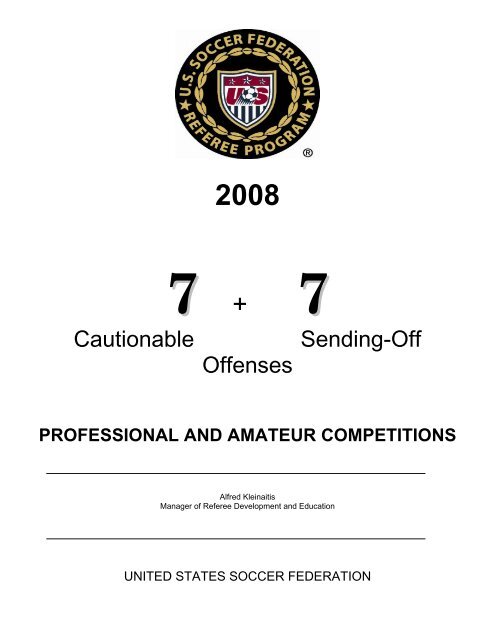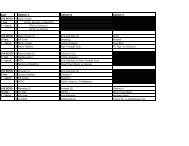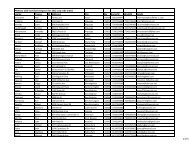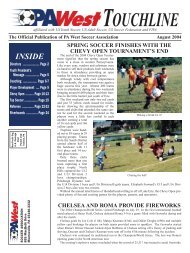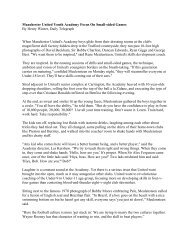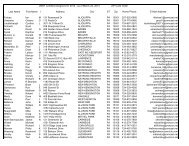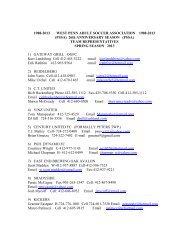Cautionable Sending-Off Offenses - PA West Soccer Association
Cautionable Sending-Off Offenses - PA West Soccer Association
Cautionable Sending-Off Offenses - PA West Soccer Association
You also want an ePaper? Increase the reach of your titles
YUMPU automatically turns print PDFs into web optimized ePapers that Google loves.
2008<br />
7 + 7<br />
<strong>Cautionable</strong><br />
<strong>Off</strong>enses<br />
<strong>Sending</strong>-<strong>Off</strong><br />
PROFESSIONAL AND AMATEUR COMPETITIONS<br />
Alfred Kleinaitis<br />
Manager of Referee Development and Education<br />
UNITED STATES SOCCER FEDERATION
7<br />
CAUTIONABLE OFFENSES<br />
A player is cautioned and shown the yellow card for committing any of the following seven offenses<br />
(actions of special concern to FIFA are displayed in bold print):<br />
1. is guilty of unsporting behavior (UB)<br />
(The following actions are examples only and are not a complete list.)<br />
a. Commits a direct free kick foul in a reckless manner (for example, charging, pushing, tripping)<br />
b. Commits a direct free kick foul in a reckless manner while tackling for the ball from any direction<br />
c. Commits a tactical foul designed to interfere with or impede an opposing team’s attacking play (e.g.,<br />
pushing an opponent, blatantly holding an opponent or an opponent's uniform, handling the ball<br />
deliberately)<br />
d. Handles the ball deliberately to score a goal<br />
e. Commits an act which, in the opinion of the referee, shows a lack of respect for the game (e.g., aggressive<br />
attitude, inflammatory behavior, or taunting)<br />
f. Fakes an injury or exaggerates the seriousness of an injury<br />
g. Fakes a foul (dives) or exaggerates the severity of a foul<br />
h. Interferes with or prevents the goalkeeper from releasing the ball from the hands into play<br />
i. Verbally distracts an opponent during play or at a restart<br />
j. Unfairly distracts or impedes an opponent performing a throw-in<br />
k. Changes jerseys with the goalkeeper during play or without the referee's permission (both players must be<br />
cautioned)<br />
l. Engages in trickery to circumvent the goalkeeper's limitation on handling the ball played from a teammate's foot<br />
(the defender who initiates the "trickery" is cautioned, the decision does not require that the goalkeeper actually<br />
handles the ball, and the misconduct can occur during dynamic play or at a restart)<br />
m. Makes unauthorized marks on the field<br />
n. Removes the jersey or covers the face with a mask or similar device after scoring a goal<br />
o. Uses an artificial aid to unfairly assist play (for example, leaning on the shoulders of a teammate, using an article<br />
of clothing to avoid direct contact with the ball, moving or removing a corner flag on a corner kick, hanging on a<br />
crossbar)<br />
p. Uses tobacco or tobacco products in any form in the area of the field<br />
2. shows dissent by word or action (DT)<br />
a. Verbally or through action disputes or shows contempt for an official’s decision<br />
b. If playing as a goalkeeper, leaves the penalty area (not beckoned by the referee) to engage an official in debate<br />
regarding a decision<br />
3. persistently infringes the Laws of the Game (PI)<br />
a. Repeatedly fouls or participates in a pattern of fouls directed at an opponent<br />
b. Violates Law 14 again, having previously been warned<br />
c. If playing as goalkeeper, wastes time, having previously been warned or penalized for this behavior
4. delays the restart of play (DR)<br />
a. Kicks or throws the ball away or holds the ball to prevent a free kick restart by an opponent<br />
b. Kicks or throws the ball away or holds the ball to prevent a throw-in or corner kick by an opponent<br />
c. Fails to restart play after being instructed to do so by the referee or hinders the restart of play<br />
d. Excessively celebrates a goal<br />
e. Fails to return to the field upon conclusion of the midgame break, fails to perform a kick-off when signaled to do<br />
so by the referee, or fails to be in a correct position for a kick-off<br />
f. Provokes a confrontation by deliberately touching the ball after the referee has stopped play<br />
5. fails to respect the required distance when play is restarted with a corner kick, free kick or throw-in<br />
(FRD)<br />
a. Does not retire at least ten yards away from an opponent’s free kick<br />
b. Does not retire at least ten yards away from an opponent’s corner kick<br />
c. Does not retire at least two yards away from an opponent's throw-in<br />
6. enters or re-enters the field of play without the referee’s permission (E)<br />
a. After having previously been instructed to leave the field to correct equipment<br />
b. After having previously been given permission by the referee to leave the field due to an injury<br />
c. After having previously been instructed to leave the field due to bleeding or blood on the uniform<br />
7. deliberately leaves the field of play without the referee’s permission (L)<br />
a. To place an opponent in an apparent offside position<br />
b. Other than through the normal course of play<br />
A substitute or substituted player is cautioned and shown the yellow card<br />
if he commits any of the following three offenses:<br />
1. is guilty of unsporting behavior<br />
2. shows dissent by word or action<br />
3. delays the restart of play<br />
If a substitute who enters the field of play without the permission of the<br />
referee is to be cautioned, the official reason given must be “unsporting<br />
behavior” – this applies as well to previously substituted players except<br />
where the rules of competition allow unlimited re-entry with the permission<br />
of the referee.
7<br />
SENDING-OFF OFFENSES<br />
A player, substitute or substituted player is sent off and shown the red card for committing any of the<br />
following seven offenses:<br />
1. is guilty of serious foul play (SFP)<br />
2. is guilty of violent conduct (VC)<br />
3. spits at an opponent or any other person (S)<br />
4. denies the opposing team a goal or an obvious goal-scoring opportunity by deliberately handling<br />
the ball (this does not apply to the goalkeeper within his or her own penalty area) (DGH)<br />
5. denies an obvious goal-scoring opportunity to an opponent moving towards the player’s goal by<br />
an offense punishable by a free kick or a penalty kick (DGF)<br />
6. uses offensive, insulting or abusive language and/or gestures (AL)<br />
7. receives a second caution in the same match (2CT)<br />
A substitute or substituted player who commits any violent act<br />
should be sent off and shown the red card for Violent Conduct.


